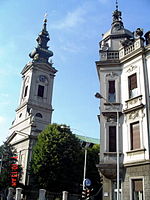Princess Ljubica's Residence
Architecture of SerbiaBuildings and structures in BelgradeCultural Monuments of Exceptional Importance (Serbia)Houses completed in 1831Obrenović dynasty ... and 2 more
Ottoman architecture in SerbiaPalaces in Serbia

Princess Ljubica's Residence (Serbian: Конак књегиње Љубице, Konak knjeginje Ljubice) is a palace located in Belgrade, the capital of Serbia. Because of its cultural and architectural importance the residence has been designated a Monument of Culture of Exceptional Importance.
Excerpt from the Wikipedia article Princess Ljubica's Residence (License: CC BY-SA 3.0, Authors, Images).Princess Ljubica's Residence
Кнеза Симе Марковића, Belgrade Old Town (Stari Grad Urban Municipality)
Geographical coordinates (GPS) Address Phone number Website External links Nearby Places Show on map
Geographical coordinates (GPS)
| Latitude | Longitude |
|---|---|
| N 44.817222222222 ° | E 20.452222222222 ° |
Address
Конак кнегиње Љубице
Кнеза Симе Марковића 8
11000 Belgrade, Old Town (Stari Grad Urban Municipality)
Central Serbia, Serbia
Open on Google Maps











